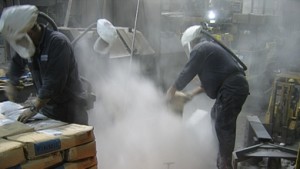Professional Safety Magazine –
A known occupational hazard, silica exposure is directly related to increased risks of silicosis and lung cancer. With growing public awareness of the hazards involved with silica, OSHA is expected to expand regulations in the coming year.
Silica exposure at OSHA’s current PEL has a lifetime risk of 10% for silicosis and 30% risk for lung cancer. Aiming for risk levels below 5%, experts are advocating for the reduction of the PEL in an attempt to reduce the overall health hazards. In addition to lowering the PEL, changing how workers protect themselves from exposure will help alleviate the dangers.
Using coveralls and respirators will protect workers against direct exposure while on the job site. Respirator use is essential, but workers typically remove them when they are away from the immediate area, resulting in exposure to the silica dust remaining on their coveralls. While minimal compared to the exposure at the work station, this remaining dust still poses a health hazard not only to the worker but to the unprotected individuals working close by. Decontamination before removing respirators and returning to other areas of the project site will greatly reduce further exposure to silica dust.
OSHA’s standard recommends HEPA vacuuming and wet methods for decontamination, but studies show air showers work just as well. It is highly encouraged to use a direct-reading instrument to confirm successful decontamination. A simple visual confirmation does not guarantee full decontamination.
In anticipation of OSHA expanding the enforcement of silica regulations, it is important to look closely at housekeeping and worker decontamination protocols. For consultation on best practices and procedures, please contact The Integrated Group at 425-822-8500 or info@theintegratedgroup.com







No comments yet.